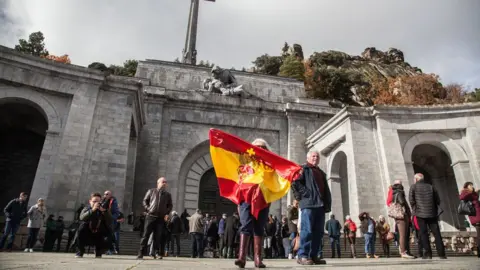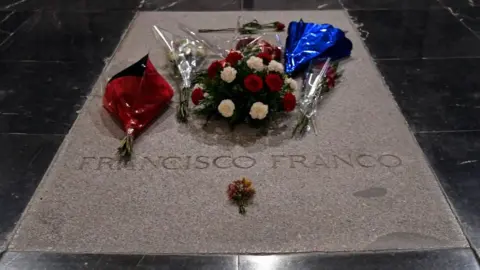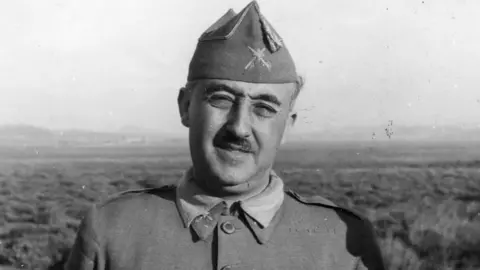Franco exhumation: Why is Spain moving a dictator's remains?
The burial place of Spain's fascist dictator General Francisco Franco has been the subject of fierce debate for decades.
But the final chapter in this long saga is approaching. The government says Franco's remains will be exhumed on Thursday and moved to a cemetery in Madrid.
But why were there calls for Franco's remains to be moved in the first place? And why has the issue proved so controversial?

Franco ruled Spain from 1939 until his death in 1975. He was buried in a mausoleum called the Valley of the Fallen, just outside Madrid.
But that site has become a shrine for the far right and is loathed by many Spaniards.
Spain's Socialist government plans to move Franco's remains next to his wife's grave in a cemetery in Madrid.
The exhumation is likely to last about three hours. The remains will probably be transferred by helicopter to avoid any protests.
Franco's family and his far-right supporters tried in vain to block the government's plan.

Franco won Spain's 1930s civil war, which was started when he rebelled against the elected leftist government.
He established a dictatorship and proclaimed himself head of state. He maintained a tight grip on power until his death in 1975, after which Spain transitioned to democracy.
Democracy is well established now, but the Franco era still haunts Spain. There was an unwritten "pact of forgetting" during the democratic transition and statues of Franco were removed and streets were renamed.
His embalmed body currently lies at the huge Valley of the Fallen mausoleum alongside tens of thousands of victims from both sides of the civil war.
But the site is reviled by many Spaniards who see it as a place dedicated to the victory of Franco's nationalist forces over their Republican opponents. It was also partly built by political prisoners, whom Franco's regime subjected to forced labour.
 Getty Images
Getty ImagesThe site is a shrine for Spain's far right who pay homage to the dictator there. It is often where Franco's supporters gather to mark the anniversary of his death.
But Spain's socialist government, in power since last June, made removing Franco's remains one of its key promises.
It wants the Valley of the Fallen to become "a place of commemoration, remembrance and homage to the victims of the war". It sees the presence of Franco's remains there as an affront to a mature democracy.
Many descendants of Franco's victims support the plan to bury his remains elsewhere. But the issue has largely split public opinion across Spain.
Last August, despite objections from his family and the right-wing People's and Citizens parties, the government approved the exhumation. It wanted to find a more low-key burial place where the dictator's followers would find it harder to pay tribute.
But Franco's family (who would rather he wasn't moved at all) said he should lie in a family crypt in the Almudena Cathedral - right in the centre of Madrid.
 Getty Images
Getty ImagesThe government argued that the former dictator should not be placed anywhere he could be glorified.
It also said there were potential security issues with the cathedral site. As it is a Catholic church, the Vatican also weighed in and backed the government's search for an alternative location.
Then, last month, an appeal by Franco's family against the exhumation was thrown out by the Supreme Court. It unanimously backed the government's plan to move his remains.
Franco will be reburied at El Pardo-Mingorrubio cemetery. The exhumation is set to start at 10:30 (08:30 GMT) on Thursday.
The government wanted to carry it out before elections on 10 November and so a deadline - 25 October - was set for the exhumation. Spain's El País daily says it will be attended by a forensic scientist, relatives of Franco and Justice Minister Dolores Delgado.
The cost of removing the granite slab, weighing 1.5 tonnes, is €3,090 (£2,657; $3,454), the daily reports.

Francisco Franco, 1892-1975
 Getty Images
Getty Images
- Born in Galicia to a military family, became the youngest general in Spain in the 1920s
- Following the election of the leftist Popular Front in 1936, Franco and other generals launched a revolt, which sparked the three-year civil war
- Helped by Nazi Germany and Mussolini's Italy, Franco won the war in 1939 and established a dictatorship, proclaiming himself head of state - "El Caudillo"
- Franco kept a tight grip on power until his death in 1975, after which Spain made a transition to democracy

